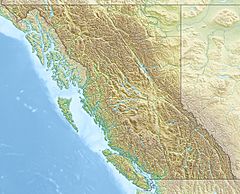Gitnadoix River facts for kids
Quick facts for kids Gitnadoix River |
|
|---|---|
|
Mouth of Gitnadoix River
|
|
| Country | Canada |
| Province | British Columbia |
| Physical characteristics | |
| Main source | Kitimat Ranges Coast Mountains 840 m (2,760 ft) 54°2′35″N 129°13′20″W / 54.04306°N 129.22222°W |
| River mouth | Skeena River 15 m (49 ft) 54°20′13″N 129°13′12″W / 54.33694°N 129.22000°W |
| Length | 38 km (24 mi) |
| Basin features | |
| Basin size | 546 km2 (211 sq mi) |
The Gitnadoix River is a special river in British Columbia, Canada. It's a tributary (meaning it flows into) the larger Skeena River. The river starts in the Kitimat Ranges mountains. It then flows about 38 km (24 mi) north. You can find its mouth about 45 km (28 mi) west of a town called Terrace.
The name "Gitnadoix" comes from the Tsimshian language. It means "people of the swift water." The Gitnadoix River area was once home to the Tsimshian Gitnadoix First Nation. Their main village was right where the Gitnadoix River meets the Skeena River. Today, there are eight Tsimshian Lax-kw'alaams First Nation Indian reserves in the Gitnadoix River area. These places are important for fishing and as traditional homes.
The river's drainage basin (the area of land where all the water flows into the river) covers 546 km2 (211 sq mi). This area is very mountainous and has many glaciers. Some peaks reach over 2,000 m (6,600 ft) high. The entire river area is protected. It's part of the Gitnadoiks River Provincial Park and Gitnadoiks River Protected Area. This means no logging, mining, or big power projects are allowed. No one lives in the watershed permanently. A natural gas pipeline crosses the area, but it's about 400 m (1,300 ft) away from where the river joins the Skeena. Many people enjoy sport fishing here. They catch salmon, steelhead, Dolly Varden trout, and cutthroat trout.
Contents
River's Journey: Where the Gitnadoix Flows
The Gitnadoix River begins at a lake near Kadeen Mountain. This spot is in the Kitimat Ranges of the Coast Mountains. The river flows north from there, passing through Alastair Lake. It continues north, collecting water from many smaller streams. These streams come from the tall, glaciated mountains nearby.
Main Streams Joining the Gitnadoix
Some of the biggest streams that add water to the Gitnadoix River are:
- Kadeen Creek
- Magar Creek
- Dogtag Creek
- Clay Creek
These streams bring a lot of water to the Gitnadoix.
First Nation Reserves Along the River
As the Gitnadoix River flows, it passes by several Indian reserves. These are traditional lands of the Tsimshian Lax-kw'alaams First Nation. The reserves include Alastair 82, Alastair 81, Alastair 80, Tsemknawalqan 79, Iakwulgyiyaps 78, and Psacelay 77. Right at the river's mouth, you'll find Gitandoiks 76 and Gitandoiks 75.
Nature's Story: The Gitnadoix Valley
The Gitnadoix Valley was once a fjord, which is a long, narrow inlet of the sea. After the last Ice Age (the Pleistocene period), the land slowly rose up. This process is called isostatic uplift. Over time, the valley filled with sediment (like dirt and rocks).
Valley Shape and River Flow
The flat area at the bottom of the valley, called the floodplain, is about 1 km (0.62 mi) wide. The Gitnadoix River winds through this flat land. It often flows in many different braided channels, looking like a braid. The valley itself is U-shaped with very steep sides. Every year, avalanches slide down these slopes, sometimes reaching the valley floor.
Forests and Plant Life
The forests in the Gitnadoix watershed are amazing. In the valleys and on slopes up to about 600 m (2,000 ft), you'll find tall western hemlock and Sitka spruce trees. There are also some stands of western red cedar. As you go higher up the mountains, the trees change. You'll see mountain hemlock and then alpine plants, which are tough plants that grow in cold, high places. North of Alastair Lake, the valley becomes swampy. Here, you'll find scattered cottonwood trees and patches of other conifer (cone-bearing) trees.
Fish and Aquatic Life
The Gitnadoix River is super important for salmon. Many different kinds of fish live here, including:
- sockeye salmon
- coho salmon
- chum salmon
- Chinook salmon
- pink salmon
- steelhead trout
- rainbow trout
- cutthroat trout
- Dolly Varden trout
- mountain whitefish
- bull trout
- largescale sucker
- peamouth chub
- three-spined stickleback
- prickly sculpin
Wildlife in the Watershed
The Gitnadoix watershed is home to many different animals. You might spot:
- moose
- beaver
- otter
- mink
- wolf
- mountain goat
- Many kinds of waterfowl (like ducks)
- Shorebirds
- eagles
- hawks
- hummingbirds
- swallows
- thrushes
- crows
- woodpeckers
- warblers
- sparrows
One very special bird that nests here is the Trumpeter swan. The Gitnadoix watershed is one of only three places in British Columbia where these swans are known to nest!
See also


